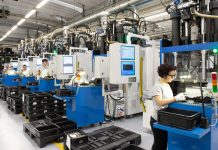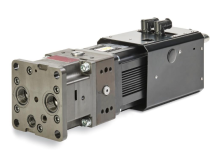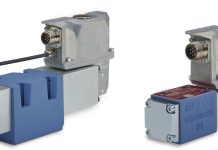Superconductors are opening up possibilities for entirely new, previously unthinkable applications in automation technology. They allow contact-free, frictionless manipulation of objects – efficiently and with minimal energy consumption. Their dust- and abrasion-free operation is ideal for the protective transport of workpieces in highly clean environments. Objects can even be moved from behind walls. Festo has already been investigating superconductor technology and its industrial application for several years. The German company is showcasing once again three new, innovative application concepts.
Superconductors are materials which below a certain temperature can “freeze” the field of a permanent magnet at a predefined distance and can thus hold it in suspension. The resulting air gap remains stable in any spatial position. By this means, objects can be stored contact-free without any control technology and be moved with minimal expenditure of energy. «There are already various solutions for storing and moving objects without contact. But only with superconductivity is it possible at the same time to execute a rotation through 360° in any spatial direction – without the need for intricate control technology,» explains Georg Berner, Head of Strategic Corporate Development, Group Holding Festo. In addition to classic fields of automation such as the suspended low-energy transport of workpieces in production, automation with superconductors can even make inroads into areas of application that until now have been regarded as not or only hardly accessible to automation. Objects can now be manoeuvred from behind walls, for example, or be conveyed across system boundaries without contact.
Festo, one of the the first suppliers of automation technology to investigate this potential, is once more demonstrating three potential applications: the storage and movement of an object on suspended rollers; a suspended rotating conveyor shaft with contact-free electric drive; and the active, controlled conveyance of a suspended magnetic object carrier from one superconductor automation module to the next.
SupraCycle – contactless transfer
SupraCycle for the first time demonstrates how a suspended permanent magnet can be actively transferred from one superconductor automation module to another.
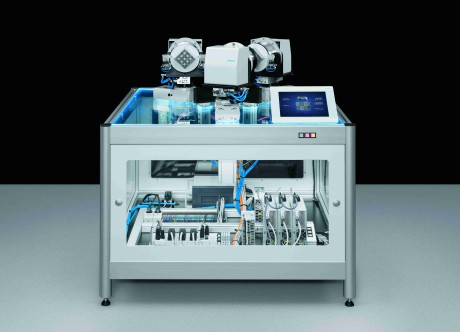
Three cryostats with superconductors rotatable through 360° are mounted on a base plate. Two magnetic object carriers are suspended in the cryostats at a distance of a few millimetres to the superconductors and then transferred in turn from one cryostat to the next. A device on the cryostat provides the necessary integrated intelligence. A possible application based on SupraCycle is the contactless transfer of an object carrier between two systems or across system boundaries, as this exhibit demonstrates using glass bottles as an example. Arbitrarily long process chains are thus made possible for the first time.
SupraHelix – a rotating conveyor shaft
The SupraHelix exhibit makes use of two cryostats with superconductors that are arranged alongside each other on a semi-rotary drive unit. When cooled to below their transition temperature, they suspend a shaft with integrated permanent magnets beneath them and hold it at a distance of eight millimetres. The shaft is inclined at 40° by means of the semi-rotary drive. A permanently excited integrated stepper motor sets it in rotation without contact, so that it can convey individual metal rings upwards along its thread.
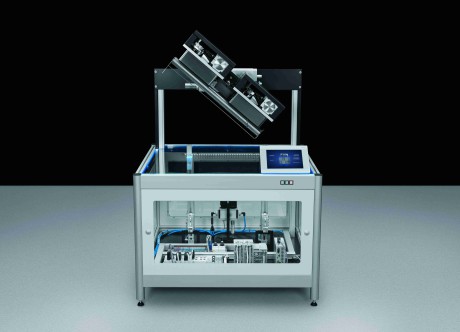
This exhibit shows how ring-shaped workpieces can be transported from one processing station to the next. This elastically suspended driven shaft could also be used for polishing or grinding non-ferromagnetic workpieces.
SupraCarrier – storing and moving objects on suspended rollers
Two cryostats with superconductors are mounted on an electrical axis, above each of which two magnetic transport rollers are held in suspension. A flat workpiece carrier rests on the rollers. The axis moves the superconductor elements horizontally. Between these and the suspended rollers is a cover plate with openings through which the rollers are retracted when the cryostats are lowered; the workpiece carrier then lies on top of the cover plate. Suspended transport rollers such as these could be used to move flat, non-ferromagnetic products of all sizes.
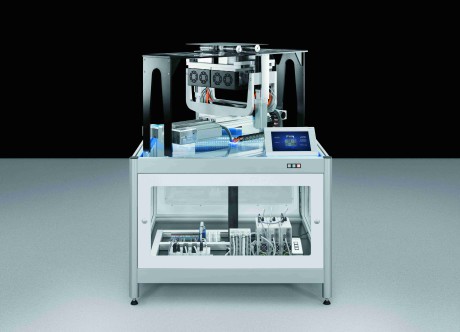
The conveyor unit does not require lubricants and is very easy to clean – the cover plate protects the automation modules from soiling, and the passive rollers can be easily removed and be cleaned separately from the system either chemically or by means of heat. Superconductor technology also has further positive characteristics: the application is almost maintenance-free and highly durable; it operates silently and the air gap has an insulating effect.
Applications for production of the future
After several years of intensive research work, Festo is cooperating with partners and customers to examine their ideas for specific applications. «We are now not merely showing impressive levitation effects and the opportunities offered by superconductor technology, but are actively discussing their potential together with the automation industry. We are currently working towards initiating our first pilot projects,» said Georg Berner.
(Photos: Festo AG & Co. KG)

